The Best Cities in Morocco
Although the traditional medinas, souks, bazaars and market squares are features of all Moroccan cities, each one has its own unique character.
If you’re looking for a city break in Morocco or want to stop off on your way to the mountain or the desert regions, be sure to visit at least one of the country’s fascinating cities.
To help you decide, here’s a guide to the best cities in Morocco.
Tangier
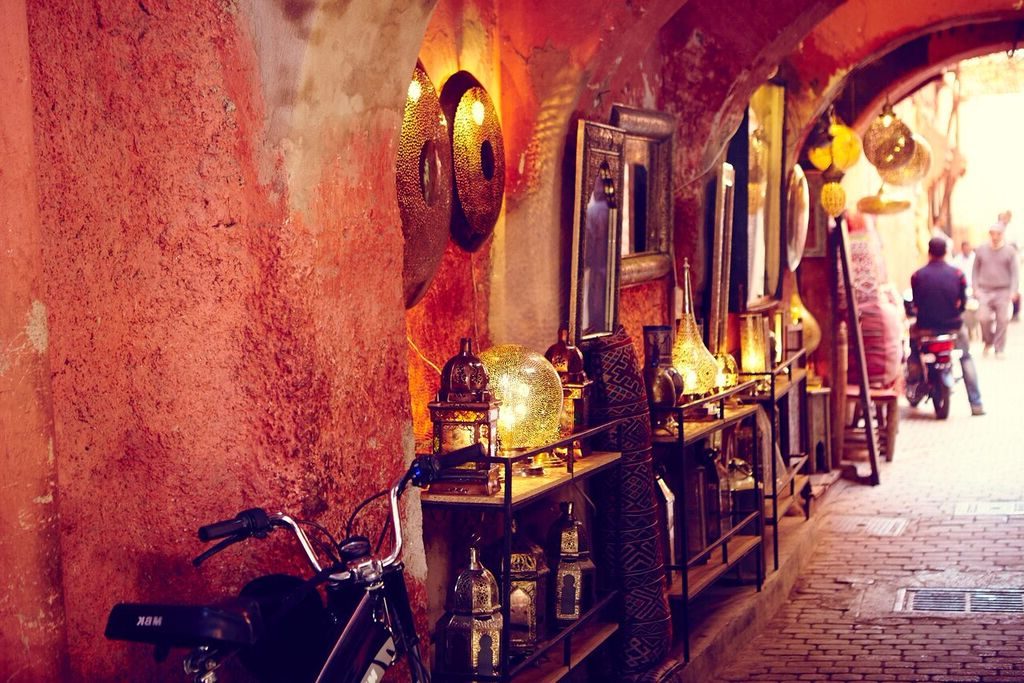
Across the Strait of Gibraltar in the far north of Morocco, Tangier is the meeting point between Europe and Africa, known as the ‘Gateway to Africa’.
This unique city is a melting pot of cultures and influences that can’t be found anywhere else in the country.
In the past, Tangier had a rather sleazy reputation, frequented by eccentrics, musicians, artists and spies. However, in recent times the city has undergone major re-development including a new business district and marina, transforming it into a vibrant and cosmopolitan hub where touches of modernity blend with the ancient historic charm of past centuries.
HIGHLIGHTS
The Grand Socco and Mendoubla Gardens
Once the main market in Tangier, the Grand Socco is a large cobblestone square with a fringe of palm trees and lovely ocean views. It’s also the entrance to the Medina and offers visitors a taste of new and old Tangier, where you can watch parades go by and see local women dressed in traditional costumes.
The Mendoubla Gardens next to the square offer a tranquil spot to escape the hustle and bustle of the city.
The Medina
Within the walls of a 15th century Portuguese fortress, there’s a labyrinth of winding streets and well-lit alleyways to explore. A mix of shops, bazaars and traditional Moroccan homes give a fascinating insight into the daily life of Tangier’s people. Stop at the weavers, brass works and leather goods souks (bazaars) and watch craftsmen at work, then climb up to the Kasbah and watch the snake charmers in the square. Exit through the Bab Bhar gate and admire the far-reaching views. On a clear day, you can even see the Rock of Gibraltar.
The Caves of Hercules
Once you’ve explored the city, take a trip to the coast and visit the Caves of Hercules, named after the Greek hero who supposedly spent time here. The steps will take you down into the caves where you’ll find a gaping hole in the shape of Africa, overlooking the ocean.
Marrakech
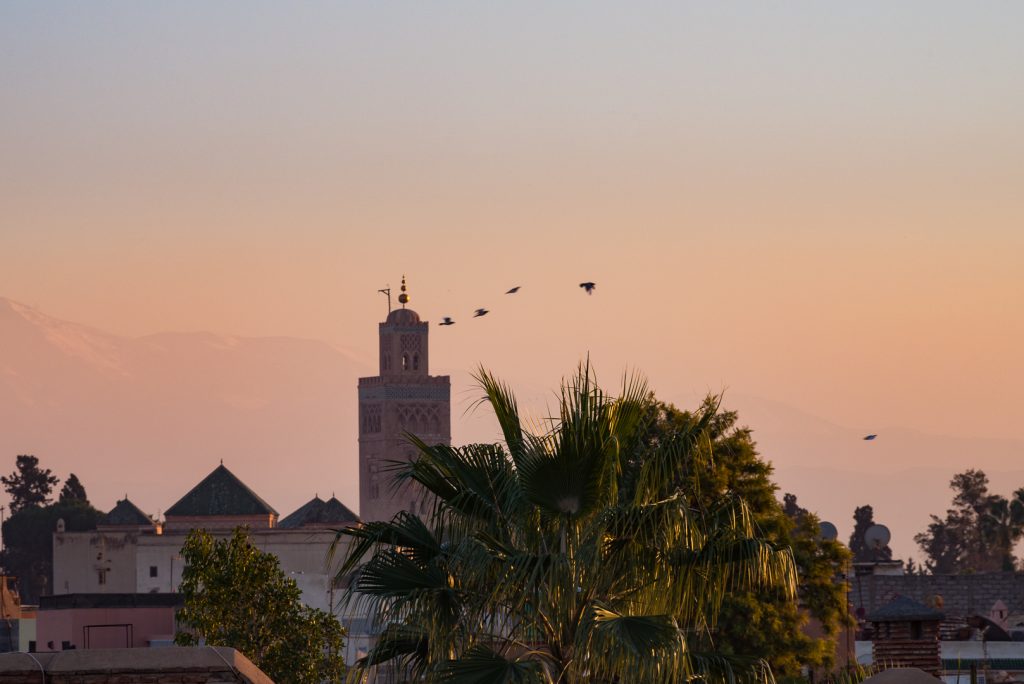
When visiting the ‘Red City’ be prepared for a sensory explosion. The heady aromas of exotic spices, intense flavours, colours, sights and sounds of this magical city will entice and enchant you.
With its spectacular backdrop of the snow-capped Atlas Mountains, Marrakech, in the south of Morocco, has been attracting visitors since the 11th century. If you love photography, then Marrakech is one of the best places to go to take amazing photos in Morocco. Today it’s an eclectic mixture of ancient and modern cultures with a vibrant buzz like nowhere else.
HIGHLIGHTS
Jemaa el Fna
The most famous marketplace in Morocco, if not the world, Jemaa el Fna in the main square of Marrakech, offers visitors a truly unforgettable experience.
Don’t be put off by the noise, dust and chaos; it all adds to the charm. Here you’ll find mountains of spices, street food stalls and artisan workshops selling handcrafts such as jewellery, leather goods, woven carpets and homewares. During the day, it’s busy and hectic, but it’s the evening when the market really comes to life. The air is filled with the tantalising aroma of fired-up grills and the sounds of musicians preparing to perform. Every night is carnival night at Jemaa el Fna with street theatre, musical performers, snake charmers and acrobatic acts partying until dawn.
Jardin Majorelle
Escape the market mayhem at Jardin Majorelle. This beautiful garden was created by French painter, Jacques Majorelle, and provides a calming oasis of tranquillity in the heart of Marrakech.
Home to over 300 species of plants from five continents, the gardens feature winding, tree-lined pathways and meandering streams. It is also home to Musée Berbère, an art deco museum housing over 600 artefacts from the country’s Berber people.
Koutoubia Mosque
Just opposite Jemaa el Fna, is the 12th century Koutoubia Mosque. It’s the largest mosque in Marrakech and one of the finest examples of Moorish architecture in Morocco.
Although non-Muslims are not permitted to enter, it’s definitely worth looking around the outside. Arrive just before sunset then admire the changing colours of the exterior as dusk descends, while sipping on a sweet mint tea from one of the surrounding roof terrace cafés.
Bahia Palace
This 19th century palace is a prime example of the opulence and wealth of its owners at the time. Built for the Ba Ahmed’s concubines, the palace features a lavishly decorated harem adorned with silk woven panels, stained glass windows and intricately painted ceilings.
There are several tiled courts with water features where the women would have washed, lavish reception areas with painted wooden ceilings, stucco panels, colourful tiles and a grand courtyard laid in white Carrera marble.
Fez
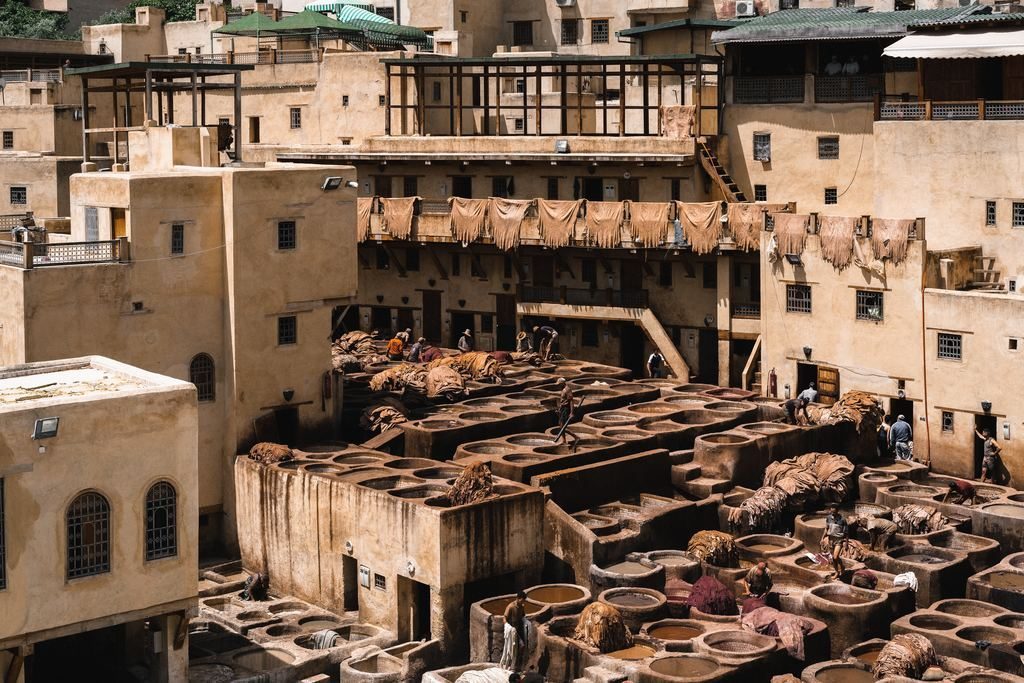
Nestled in a valley between the Rif and the Atlas Mountains, you’ll find Fez. Founded in the 9th century, it’s the largest and oldest medieval city in the world.
Sympathetic restoration to the crumbling medina walls and new luxury hotels have brought the city into the 21st century without losing its ancient charm.
HIGHLIGHTS
Bab Boujloud
The Blue Gate is a magnificent arched entranceway to the medina of Fez. It’s named after the beautiful patterned fassi tiles that adorn it. The gate was built by the French in 1913 and is situated next to the original 9th century medina entrance gate.
The Medina
Morocco’s most impressive and largest medina has 9,500 streets and alleys to explore. There are no cars inside the medina, only donkeys and mules that pull carts loaded with goods up and down the winding streets. It’s the largest car-free urban area in the world.
Theme-related colour-coded routes are painted on the streets, guiding visitors to palaces, gardens, markets and mosques.
One highlight of the many souks here is the weavers’ souk. Watch the craftsmen working on large wooden looms, creating a colourful array of scarves, robes and bedspreads. Then head to the rug shop where you’ll find mountains of colourful rugs with distinctive patterns that relate to the 45 different tribes.
There are so many handicrafts here, from jewellery and leather goods to metalwork and handmade cobalt blue ceramics, you’ll be spoilt for choice. But be prepared to haggle for the best price. Even if you don’t buy anything, it’s still fascinating watching the craftsmen as they work.
You can’t mistake what the butcher’s shops are selling here; they have camel heads hanging in the windows. Apparently, the hump is the most delicious part. If you’re game, you can try a camel burger at Café Clock which is located opposite the Water Clock, past the meat and vegetable stalls of Talaa Kbira.
Don’t miss a visit to the bakers; there are hundreds in the medina. Watch as they make khobz bread, place the dough onto palettes then shove them into huge clay ovens to be baked. Local women also bring their homemade dough here to be baked.
Kairouine Mosque
Although non-Muslims are not permitted entry, you may get a glance of the beautiful interior from the outside. Look out for the two magnificent chandeliers, which were originally church bells from Andalucia.
Chouara Tannery
If you can stand the pungent smell, visit the tannery quarter for a medieval Moroccan experience.
The skins are dunked in huge vats of cow urine, then softened with acidic pigeon excrement before barefooted workers tread them into the dyeing pits. It’s a smelly, but fascinating spectacle to watch.
Leather goods are sold in stores around the tannery, and mint sprigs are offered to help counteract the stench.
Jhan Sbil Gardens
After a busy day at the medina, relax in the peaceful haven of Jhan Sbil Gardens. There are 18.5 acres of tranquillity to explore. The gardens feature rows of colourful flowerbeds, weeping willows, citrus trees and water fountains including a recently renovated water wheel.
Madrasa Bou Inania
One of the few religious buildings in Morocco open to all faiths, the 14th century Islamic college is a fine example of Marinid architecture, featuring intricate wooden carvings, stucco work and floor to ceiling zelij mosaic tiled walls.
Taroudant
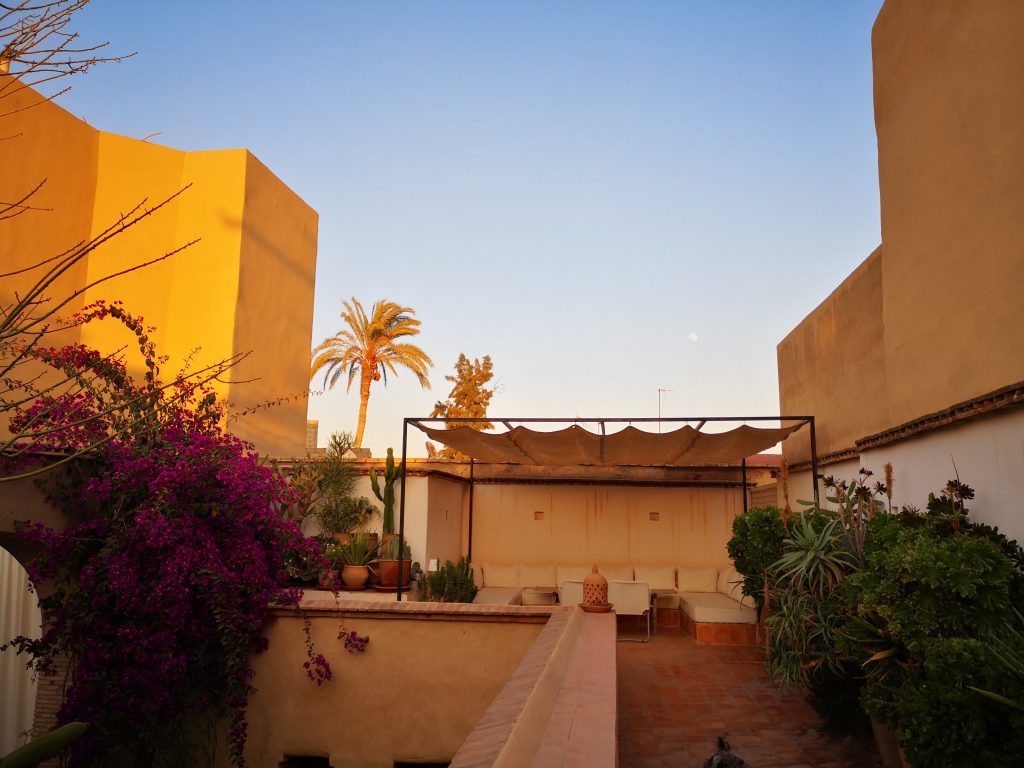
Set in the beautiful Souss Valley, the walled town of Taroudant was once the capital of Morocco, and is often referred to as ‘little Marrakech’.
Taroudant is the perfect base for trekking in the Atlas Mountains. There are fewer tourists, it’s less chaotic than the larger cities, and has a relaxed and friendly atmosphere.
The market town offers a fascinating insight into traditional Moroccan culture and the Berber way of life.
HIGHLIGHTS
The Ramparts
The outer walls of the town are the best-preserved pisé walls in Morocco. The walls feature squared turrets and nine gates to the town. Take a horse carriage ride around the exterior and watch as the red mud walls change colour in the late afternoon.
Kasbah
The ancient quarter was originally a fortress and today is a residential area with winding streets, alleyways, low arches and tiny squares.
Place al-Alaouyine
This charming marketplace is particularly lively during the Moroccan holidays, and features soothsayers, street performers, snake charmers and storytellers as well as the usual food and handicraft stalls.
Casablanca

Morocco’s commercial and economic hub is the most cosmopolitan city in Morocco with a distinctive European influence and vibe.
Visitors will find a wonderful mix of French colonial history, traditional Arab culture and modern European sophistication.
HIGHLIGHTS
Hassan Il Mosque
Completed in 1993, the Hassan Il Mosque is the second largest in the world, and one of the only mosques in the Arab world that non-Muslims can enter. Selected tours around the mosque are available throughout the year, but booking is essential.
The open courtyard can accommodate up to 80,000 faithful, but the best feature is the vast glass floor where up to 25,000 worshippers can pray directly over the sea.
La Corniche
This beachfront district offers visitors a European holiday experience, with pools, beach access and a range of restaurants serving European and traditional Moroccan dishes.
Museum of Moroccan Judaism
This unique museum is the only one of its kind in the Arab world. Exhibits, including paintings, artefacts and clothing, display Jewish life and the influence Judaism has had on Moroccan history.
Parc del al Ligue Arabe
Designed in 1918, the widest open space in Casablanca displays African flora, palm-lined avenues, walks and small cafés where you can take a break and watch the world go by.
Villa des Arts
Located near the park, the art museum is one of the largest in Morocco, displaying over 800 contemporary artworks that reflect Moroccan culture and heritage.
Chefchaouen
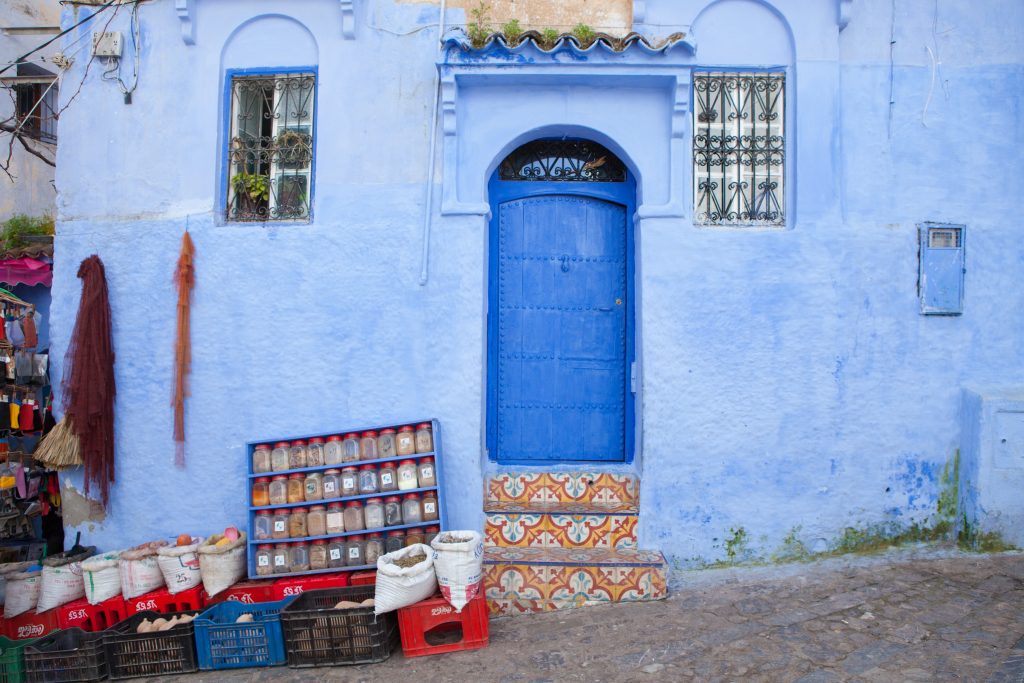
Located in the Rif Mountains, the ‘Blue Pearl’ of Morocco is famous for its blue-washed buildings and traditional medina. It’s one of the most picturesque and charming cities in Morocco and life is here is more laidback and relaxed than in the bigger cities.
HIGHLIGHTS
Leather and Weaving
The area is famous for its quality leather and woven goods, so be sure to visit one of the many shops where you can see artisans at work. Or just wander though the medina where colourful wares are displayed in a wonderful contrast to the blue painted walls.
Kasbah Museum
Set in the tranquil Andalucian Gardens, the Kasbah Museum and Art Gallery displays paintings and artefacts relating to the Chefchauoen region.
Plaza Uta el-Hammam
Enjoy street food delights in the old town square or sip on a sweet mint tea under the spectacular backdrop of the Rif Mountains.
Ras el-ma
This fresh mountain waterfall is a popular local meeting point where you can catch a glimpse of daily life as locals wash their clothes, bathe, drink and chat about their day.
Cascades d’Akchour
Thirty minutes out of town, there’s a beautiful tourist trail that leads to the bluest water pools and cascading waterfall. The perfect place to take a refreshing dip in the cool, mountain waters.
Whatever you want out of your Morocco experience at whatever pace we can create it as part of your travel plan just get in touch via info@epic.travel or fill in our contact form